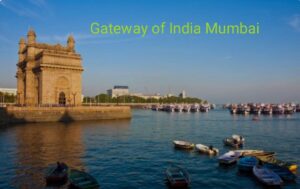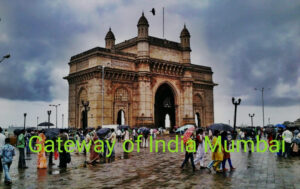Standing majestically on the waterfront of Mumbai, the Gateway of India Mumbai holds more than just architectural grandeur; it encapsulates the city’s rich history and cultural significance. This iconic monument has become synonymous with Mumbai itself, drawing millions of visitors annually to marvel at its beauty and explore its heritage.

1.Gateway of India Mumbai: Historical Background
The Gateway of India was erected during the British Raj, serving as a ceremonial arch to commemorate the visit of King George V and Queen Mary to Mumbai in 1911. Designed by architect George Wittet, this Indo-Saracenic masterpiece was completed in 1924, symbolizing the grandeur of British imperialism in India. Over the decades, it has witnessed numerous historical events, including the departure of the last British troops from India in 1948, marking the end of British rule.
2. Gateway of India Mumbai: Architectural Features
The architectural brilliance of the Gateway of India is evident in its fusion of Hindu and Muslim architectural styles, characterized by its intricate latticework, ornate domes, and towering arches. Built using yellow basalt and reinforced concrete, the structure stands as a testament to the craftsmanship of its time, attracting architects and history enthusiasts alike.

3.Cultural and Symbolic Significance
Beyond its architectural marvel, the Gateway of India holds deep cultural significance for the people of Mumbai. It serves as a symbol of the city’s resilience and spirit, witnessing numerous cultural events, rallies, and public gatherings. Today, it stands as a welcoming beacon for tourists and locals alike, symbolizing Mumbai’s cosmopolitan identity and vibrant heritage.
4.Tourist Attractions Nearby
Adjacent to the Gateway lies the gateway to another historical treasure—the Elephanta Caves, a UNESCO World Heritage site accessible by ferry. These ancient rock-cut caves house beautifully sculpted statues and reliefs dedicated to Lord Shiva, offering visitors a glimpse into India’s rich artistic and religious history. Nearby, the Taj Mahal Palace hotel beckons with its luxurious charm and historic allure, making it a favorite among discerning travelers.
Just a stroll away from the Gateway, the bustling Colaba Causeway offers a vibrant shopping experience, lined with quaint cafes, boutiques, and handicraft shops. Here, visitors can immerse themselves in Mumbai’s bustling street life, savor local delicacies, and shop for souvenirs to cherish their visit.
5.Tips for Visitors
For those planning to visit the Gateway of India, the best times are early mornings or evenings when the sea breeze adds to the ambiance. While entry to the monument itself is free, visitors should plan to arrive early to avoid crowds and capture stunning photographs against the backdrop of the Arabian Sea. Don’t forget to explore nearby attractions and indulge in local street food for a complete Mumbai experience!
Conclusion:
The Gateway of India stands as more than just an architectural marvel; it embodies Mumbai’s spirit of resilience, cultural diversity, and historical legacy. As you stand before this iconic monument, you are not just witnessing history but becoming a part of it. Whether you’re a history buff, a cultural enthusiast, or a curious traveler, a visit to the Gateway of India promises an unforgettable journey through Mumbai’s past and present.
Come, explore the Gateway of India, where history meets modernity, and discover why Mumbai is rightly called the “City of Dreams.”
FAQ:
1.Why is Mumbai called the Gateway of India?
2.What is special in Gateway of India?
3.What is the difference between India Gate and Gateway of India?
4.Essay on Gateway of India
5.5 Points on Gateway of India
6.Gateway of India essay 100 words
7.gateway of india – wikipedia
8.Gateway of India history
9.Gateway of India Delhi


Pingback: Bekal Fort: Discover the History and Beauty of Kerala’s Largest Fort - solotraveler